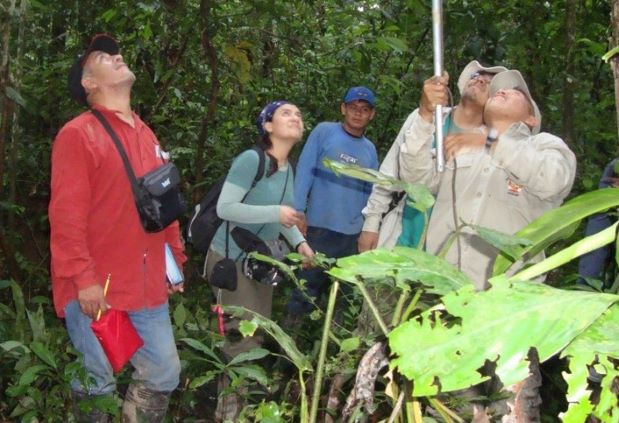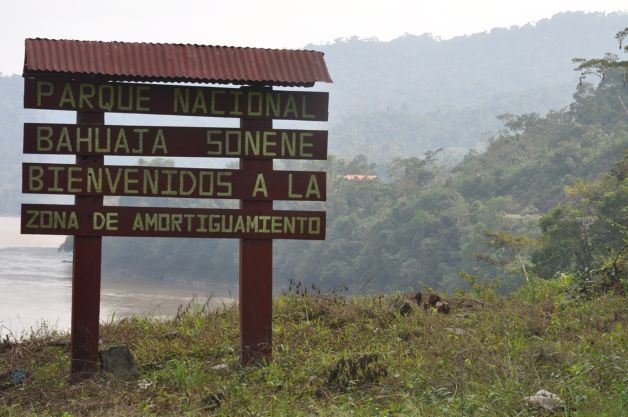The Bahuaja-Sonene National Park, which is home to both Amazonian rainforests and South American savannas, is one of the most biodiverse regions on the planet.
It is located in the provinces of Tambopata, Carabaya and Sandia, in the departments of Madre de Dios and Puno respectively, in southeastern Peru, and protects one of the few areas of the Amazon that is virtually free of human intervention.
The grasslands of the Bahuaja-Sonene savanna are enclosed by the Amazonian rain forest, making it an island in the middle of the forest.
Location
Bahuaja Sonene National Park is located in the province of Tambopata in the department of Madre de Dios and in the provinces of Carabaya and Sandia, in the department of Puno, in Peru. Its extension is 1 091 416 hectares.
Extension
Its extension is 1’091,416 hectares. The new National Park includes the entire former Pampas del Heath National Sanctuary (102,109 ha.) And a small part of the Tambopata – Candamo Reserved Zone (ZRTC).
Weather

Parque Nacional Bahuaja Sonene 
Parque Nacional Bahuaja Sonene
The Bahuaja Sonene National Park is located in a place where the humid tropical and subtropical Amazonian climate converge. The area receives annual rainfall equivalent to 2,400 mm. The average temperature is 30 ° C, but in the summer it can reach up to 38 ° C or drop to 8 ° C.
The ‘cold’, occasional Antarctic winds that enter the area, produce the low temperatures between June and July. With the rains from December to March, the pampas are covered with water, forming a huge swamp.
Bahuaja-Sonene National Park
The Bahuaja-Sonene National Park is located in the provinces of Tambopata, Carabaya and Sandia, in the departments of Madre de Dios and Puno respectively. Its extension is 1’091,416 hectares. Its presence seeks to conserve a mosaic of habitats that houses a great diversity of flora and fauna, represented by elements from both the southern and northern Amazon.
The Bahuaja-Sonene National Park protects unique elements in Peru, such as the humid tropical savanna (Pampas del Heath), habitat of species such as the marsh deer and the maned wolf, and the formations of the Candamo valley.
Inside, the cultural processes of the Ese’eja culture, an ethnic group originally and ancestrally linked to these territories, are also protected. Likewise, its establishment contributes to the sustainable development of the Madre de Dios and Puno regions.
The Bahuaja-Sonene National Park is located in the ecoregion of the humid forest of the southwestern Amazon and presents typical habitats of this forest and of the tropical premontane humid forest.
The area has lakes or lakes, palm swamps, and seasonally flooded areas. Among the habitats that stand out are the Pampas del Heath, which led to the creation of a sanctuary in 1983 for their conservation.
This large plain covered with grasslands up to 2 m high has small agglomerations of palm trees that turn into islands when the pampas are completely flooded between December and April.
In addition, its presence determines the southern limit of the tropical forests of the continent, which from here are transformed into the vast Benian savannas.
The area occupied by the Bahuaja-Sonene National Park is ancestral territory of the Ese’eja ethnic group, belonging to the Tacana linguistic family, who today are concentrated in the communally owned areas of Infierno, Palma Real and Sonene, adjacent to the Park. A fourth neighboring native community, Kotsimba, corresponds to the Pukirieri ethnic group, of the Harakmbut family.
The Bahuaja-Sonene National Park is the link that connects the protected natural areas of Peru with those of Bolivia (adjacent to the Madidi National Park), in the proposed Vilcabamba Amboró Conservation Corridor.
Visiting this corner of the country offers anyone the reasons to preserve our biological and cultural diversity. Knowing this and other places in our Amazon makes us see as small elements within an entire system so complex that it has always worked perfectly and that dazzles us with its beauty.
Biodiversity
This richness may be due to the special climatic and altitude conditions of the area, which allows a great variety of vegetation (more than 10 thousand different species of trees and plants have been cataloged).
In the eastern slopes of the Andes, high levels of endemism can be seen, so it is expected that the protected area also registers a high endemism and concentration of high biological diversity for various groups of organisms.
As an indicator of this enormous wealth, it can be mentioned that in an area of just 550 ha, 91 species of mammals, 570 of birds, 127 of reptiles and amphibians, 94 of fish, among other surprising records, have been found.
Fauna
It has been found that in the protected area there are large populations of species that in many parts of the Amazon are already rare due to overhunting, especially tapirs and spider monkeys, but also for jaguars, huanganas, medium and large monkeys and alligators. Several groups of river wolves are found in the rivers, as well as otters.
Almost 575 species of birds have been recorded in an area of 5000 ha. Likewise, this area is home to more than 1200 species of butterflies.
74 species have been recorded, including: the swamp deer, the maned wolf, the giant anteater, the short-eared bush dog, 28 species of amphibians and 17 species of reptiles.
Flora
In addition to its extraordinary fauna, Bahuaja-Sonene National Park is also home to the largest population of Brazil nut trees (Bertholletia excelsa) in Peru, with more than 30,000 hectares of land. The park also protects several native fruits, including the wild pineapple (Ananás sp.) And the guava.
Fauna in danger of extinction
But there are also species in danger of extinction, living in perfect harmony with nature, such as the giant otter (Pteronura brasiliensis) and the harpy eagle (Harpia harpyja), or the cotomono (Alouatta seniculus), one of the 9 species of monkey , or the giant armadillo (Priodontes maximus), the river wolf (Pteroura brasiliensis), the “mountain dog” (Speothos venaticus), the “black lizard” (Melanosuchus niger), the ocelot (Leopardus pardalis), the jaguarundi ( Herpailurus yaguarundi), the black caiman (Melanosuchus niger), and a great variety of parrots, such as the red-green (Ara chloroptera), or the blue-yellow parrot (Ara ararauna), the blue-headed one (Ara couloni), just to mention Some.
What to do in Bahuaja-Sonene National Park?
Adventure tourism (rafting and other activities) can be done on the Tambopata River between June and September. Along the river you can camp on its beaches from where you can see the variety of flora and fauna present. You can also visit the Heath clay lick, 7 hours from Puerto Maldonado sailing along the Madre de Dios River and the Heath. There you can see a great variety of multi-colored macaws, parrots, parakeets, ronsocos among other animals. Book the Amazon Expedition 4 Days.










